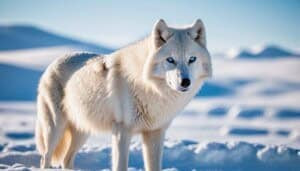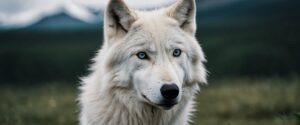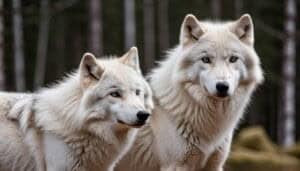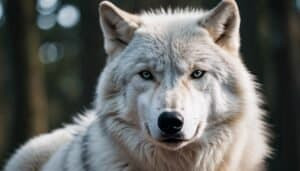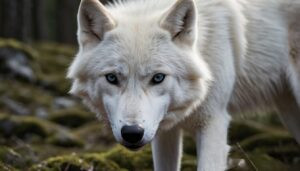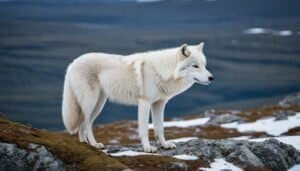Introduction
Arctic wolves have evolved remarkable adaptations to thrive in their harsh, low-light environment. This article explores the physical, environmental, and behavioral adaptations that enable Arctic wolves to see in low light conditions. We will delve into the anatomical features of their eyes, the influence of their habitat, and how their diet supports their vision
Additionally, we will examine evolutionary perspectives and compare their vision to other Arctic animals, supported by notable research findings
Adaptations of Arctic Wolves for Low Light Vision
Arctic wolves have several unique adaptations that allow them to see in low light conditions, crucial for their survival in the Arctic environment. These adaptations include specific physical characteristics of their eyes, such as the presence of the tapetum lucidum and differences from other wolf species
Key Physical Adaptations
The eyes of Arctic wolves are specially adapted to maximize their vision in low light conditions. One significant adaptation is the increased number of rod cells in their retinas. Rod cells are more sensitive to light than cone cells, which means they are more effective in dim lighting. This abundance of rod cells enables Arctic wolves to detect movement and shapes even when light levels are low, such as during long Arctic winters
Another physical adaptation is the large size of their eyes relative to their skulls. Larger eyes allow more light to enter, enhancing their ability to see in low light. Additionally, the shape and positioning of their eyes provide a wide field of vision, which is crucial for detecting prey and predators in their expansive and often dimly lit habitat
Role of the Tapetum Lucidum
A critical component of Arctic wolves’ low light vision is the tapetum lucidum, a reflective layer behind the retina. This structure acts as a mirror, reflecting light that passes through the retina back into the eye, giving the photoreceptors a second chance to capture it
This significantly increases the amount of light available to the photoreceptors, thereby enhancing vision in low light conditions. The tapetum lucidum is also responsible for the characteristic eye shine seen when light is shone into the eyes of many nocturnal animals, including Arctic wolves
Differences from Other Wolves
While all wolves have adaptations for low light vision, Arctic wolves exhibit some distinct differences. The extreme conditions of the Arctic have driven the evolution of these wolves to have more pronounced adaptations compared to their counterparts in less harsh environments
For example, the tapetum lucidum in Arctic wolves is often more developed, providing better low light vision. Additionally, the ratio of rod to cone cells in Arctic wolves is higher than in other wolves, further enhancing their ability to see in dim conditions
Environmental and Seasonal Influences
The Arctic environment imposes unique challenges on the vision of Arctic wolves. The long periods of darkness during winter and the bright, reflective snow cover in the summer require specialized visual adaptations
Impact of the Arctic Environment
The Arctic environment is characterized by extreme conditions, with prolonged periods of darkness in the winter and almost constant daylight in the summer. During the long Arctic winter, the sun remains below the horizon for extended periods, leading to continuous darkness
This lack of light necessitates adaptations in the vision of Arctic wolves to ensure they can hunt and navigate their surroundings effectively. Their eyes are adapted to capture as much light as possible, enabling them to see in the dim light of the polar night
In contrast, the summer months in the Arctic bring nearly continuous daylight, often referred to as the midnight sun. The intense, bright light and reflective snow can be harsh on the eyes. Arctic wolves’ vision must also cope with this brightness. Although their eyes are adapted for low light, they can adjust to varying light levels, protecting their eyes from damage caused by excessive brightness
Seasonal Changes and Their Effects
The drastic seasonal changes in the Arctic profoundly impact the vision of Arctic wolves. During the winter, their reliance on low light vision is paramount. The enhanced rod cells and the tapetum lucidum play critical roles in this period. These adaptations ensure that Arctic wolves can continue to hunt and survive despite the lack of sunlight
As the seasons shift and the sun returns, the wolves’ vision must adjust to the increased light levels. While their eyes are not as specialized for bright light, they possess a degree of adaptability that allows them to cope with the intense summer brightness. This flexibility is crucial for their survival, enabling them to function effectively throughout the year
Behavioral, Dietary, and Evolutionary Adaptations
Arctic wolves exhibit a range of behavioral, dietary, and evolutionary adaptations that complement their physical adaptations, further enhancing their ability to see and survive in low light conditions
Behavioral Adaptations
Arctic wolves have developed specific behaviors to cope with the low light conditions of their environment. These behaviors include increased activity during dawn and dusk when light levels are slightly higher compared to the pitch darkness of the night or the brightness of the midday sun in summer. This behavior, known as crepuscular activity, allows them to make the most of the available light
In addition to timing their activities to coincide with optimal light levels, Arctic wolves often rely on their pack structure and cooperative hunting strategies. By hunting in groups, they can better utilize their collective vision and other senses to track and capture prey. The cooperation within the pack helps mitigate the limitations of individual vision in low light conditions
Dietary Support for Vision
The diet of Arctic wolves plays a role in supporting their vision. Their primary food sources, such as caribou, muskoxen, and Arctic hares, provide essential nutrients that are beneficial for maintaining eye health. These prey animals are rich in vitamins A and E, which are crucial for good vision. Vitamin A, in particular, is essential for the production of rhodopsin, a pigment in the eyes that helps with low light vision
Moreover, Arctic wolves often consume the liver of their prey, which is particularly high in these vital nutrients. This dietary preference ensures they receive the necessary components to support their enhanced visual capabilities
Evolutionary Factors
Over time, natural selection has favored Arctic wolves with superior low light vision, leading to the development of their unique adaptations. Wolves that could see better in the dim conditions of the Arctic were more successful in hunting and survival, passing these advantageous traits to their offspring
The evolutionary pressure of the Arctic environment has driven the development of these specialized traits. The combination of physical eye adaptations, behavioral strategies, and dietary habits has created a wolf subspecies uniquely equipped to thrive in one of the most challenging habitats on Earth
Comparative and Research Perspectives
Understanding the vision of Arctic wolves involves comparing their adaptations with other Arctic animals and examining scientific research that sheds light on their unique capabilities
Comparison with Other Arctic Animals
Arctic wolves are not the only animals that have adapted to the extreme light conditions of the Arctic. Comparing their vision to other Arctic animals provides insights into the convergent evolution of low light vision
For instance, Arctic foxes and polar bears also possess the tapetum lucidum, which enhances their ability to see in dim light. However, there are differences in the extent and nature of these adaptations. Arctic foxes, being smaller and more solitary hunters, rely heavily on acute vision and hearing
Polar bears, which often hunt during the day, have eyes adapted to cope with the brightness of the snow and ice, but they also benefit from enhanced low light vision during the twilight hours of winter
Birds like the snowy owl, which are active during the Arctic winter, have large eyes with a high concentration of rod cells, similar to Arctic wolves. These comparisons highlight the diverse strategies Arctic animals have developed to handle the low light conditions, with each species fine-tuning their adaptations to their specific ecological niches
Notable Research Findings
Several studies have been conducted to understand the vision of Arctic wolves better. One significant finding is the high density of rod cells in their retinas, which supports their superior low light vision. Research has shown that Arctic wolves have a higher rod-to-cone ratio than many other wolf species, confirming their specialized adaptation to the Arctic’s dim conditions
Another area of research focuses on the genetic basis of these adaptations. Genetic studies have identified specific genes associated with the development and function of rod cells and the tapetum lucidum. These genetic markers provide evidence of the evolutionary pressures that have shaped the Arctic wolves’ vision
Behavioral studies have also contributed to our understanding, showing that Arctic wolves’ hunting patterns and pack dynamics are closely linked to their visual capabilities. Observations of their crepuscular activity and cooperative hunting strategies provide practical examples of how their vision supports their survival
Future Research Directions
Ongoing research continues to explore various aspects of Arctic wolves’ vision. Future studies aim to delve deeper into the genetic and molecular mechanisms underlying their visual adaptations. Advancements in genetic sequencing and imaging technologies will likely provide more detailed insights into the specific adaptations of Arctic wolves’ eyes
Additionally, research into the effects of climate change on the Arctic environment and its impact on the vision and behavior of Arctic wolves is an emerging area of interest. As the Arctic undergoes rapid environmental changes, understanding how these changes affect Arctic wolves’ adaptations will be crucial for their conservation
Conclusion
Arctic wolves have developed remarkable adaptations to thrive in their unique, low-light environment. This article explored various aspects of these adaptations, starting with their key physical features such as increased rod cells and the tapetum lucidum. These traits enhance their ability to see in dim conditions, distinguishing them from other wolf species
We also examined the impact of the Arctic environment on their vision, highlighting how seasonal changes require their eyes to adapt to both prolonged darkness and intense brightness. Behavioral adaptations, like crepuscular activity and cooperative hunting, were discussed, along with the dietary support from their nutrient-rich prey
The evolutionary perspective showed how natural selection has honed these traits over time, ensuring the survival of Arctic wolves in their harsh habitat. Comparative insights with other Arctic animals provided a broader understanding of the diverse strategies for low-light vision in the region
Finally, notable research findings and future directions were addressed, emphasizing the importance of continued studies to uncover the genetic and molecular mechanisms behind these adaptations and the potential impact of climate change on Arctic wolves
Understanding these unique adaptations not only highlights the incredible resilience of Arctic wolves but also underscores the need to protect their fragile Arctic habitat


